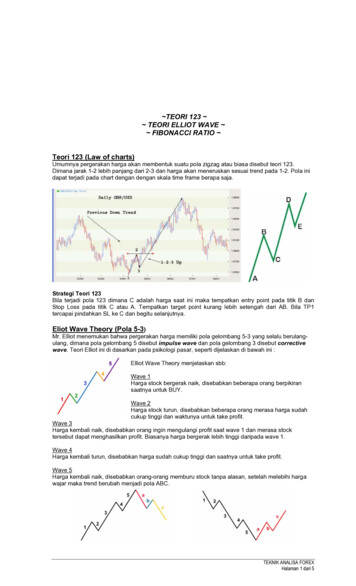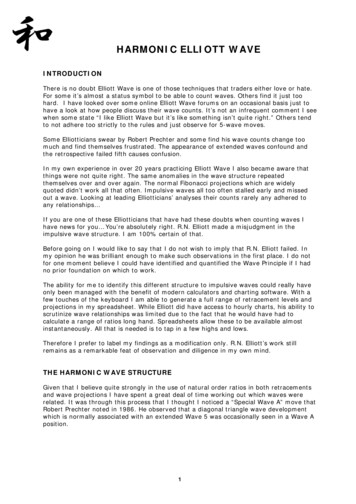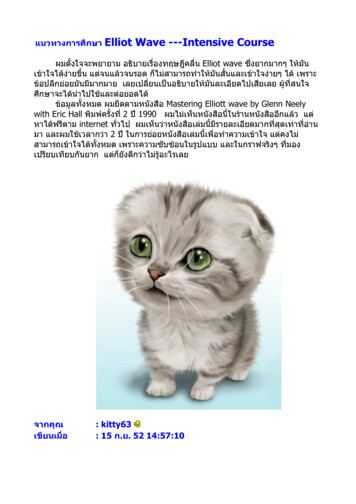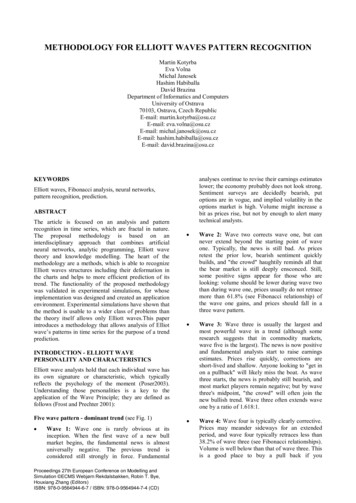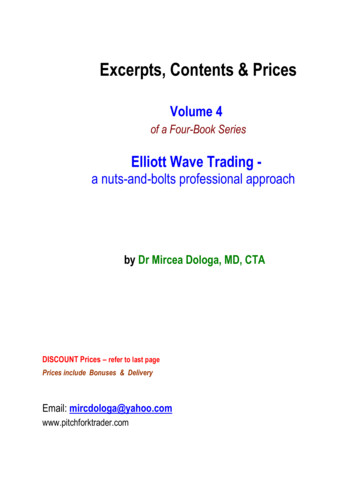
Transcription
Trading Elliott Wave Cryptocurrency‘Predictions’Ryan Wilday, Elliot Wave Trader Ryan Wilday. Duplication is prohibited without written permission
Ryan WildayIntroLead Cryptocurrency AnalystElliott Wave Trader18 Years of trading for secondary income,mostly stocks and options.Began trading cryptos off and on in 2012.Started trading cryptos extensively starting in2016.Left corporate life to trade full time in March2018.
Basics of Elliott WaveAgendaApplying ‘Fibonacci Pinball’ to do analysisTrades and StopsTrading Different Timeframes ‘EW’Technical Indicators‘Think Outloud’ Chart Request
Cryptocurrencies are particularly volatile assets. Nothing inthis document is meant to suggest that trading cryptos is agood decision for you personally.DisclaimerCryptocurrency is a new, less regulated market whichcontains risks unique to any other assets.Any mention of past results is wholly unrelated to futureperformance.Nothing in this document should be construed as anendorsement of a product, service, exchange, or any otherentity mentioned here within.
Theory developed by R.N. Elliott, published in1938.The ElliottWave TheorySuggests the market moves in waves ofsentiment, that have a mathematical sequencesimilar to mathematical structures found innature.People are part of nature and our sentiment runsits course in similar ways that natural structuresdevelop in the wild.Elliott made some phenomenal predictionsregarding the market’s progress that carriedthrough beyond his death.We find his theory works very well in cryptos aswell. They rise and fall in waves of sentiment withsome unique particulars vs. other asset classes.
[1941] should mark the final correction of the 13 year patternof defeatism. This termination will also mark the beginningof a new Supercycle wave (V), comparable in many respectswith the long [advance] from 1857 to 1929. Supercycle (V) isnot expected to culminate until about 2012.R.N. Elliott, 1941
The ElliottWave Visual
Rules and Principles:A correct Elliott wave count must observe three rules:Wave 2 never retraces more than 100% of wave 1.Wave 3 cannot be the shortest of the three impulse waves (waves 1, 3 and 5)Wave 4 does not overlap in price with wave 1, except in a diagonalDiagonals can only exist in the 1 and A (leading diagonal) or C and 5 (ending diagonal)
Elliott andSentimentEuphoriaChaseFalse ReliefTrappedDisbeliefBear ReturnsFrustrationDespair
Fibonacci Pinball(Additional ‘rules’ that EWT’s analysts and we teach to our members)Wave III 1.618 the lengthof wave I, in log
Fibonacci PinballWave II retraces .618 of I
Question Break
The Moon FlightPersonal Narrative
A personal story using Ethereum, (ETHUSD) ca. March 2017 21.50 5.9241 Cents
Ethereum, (ETHUSD) todayWave V 6900 1420 21.50 230 5.9241 Cents
2.25MBitcoin (BTCUSD) 65-150K 4700 30 3200 2.153 Cents
Your main extensions and retraces:Wave 2 typically corrects .382 to .618 in log of wave 1 with .618 as typicalWave 2 [Origin/top of wave 1) .618*top of wave 1]Wave 3 is typically 1.382 to 1.618 of Wave 1 in logWave 3 [(top of wave 1/Origin) 1.618*bottom of wave 2]
Your main extensions and retraces (cont):Wave 4 corrects to the .764 or 1.0 extension of Wave 1Wave 4 [(top of wave 1/Origin) 1*bottom of wave 2]Also wave 4 ideally retraces .382 of the third, and tolds .5 at worseWave 5 typically tops 1.764 to 2.0 of Wave 1 in logWave 5 [(top of wave 1/Origin) 2*bottom of wave 2]
Subwaves of three:i of Wave 3 is typically .382 - .764 of Wave 1ii of Wave 3 is typically corrects to the .236 to .382 of Wave 1iii of Wave 3 typically hits the 1.0 to 1.382 of Wave 1iv of wave 3 typically corrects to the .618 to .764 of Wave 1
Dealing with the extended third:When the third extends past the 1.618, sometimes to the 2.618, assume the4 will retrace .382 to .5 of the third, and the fourth will be .618 to 1.0 ofwave 1.
Question Break
Types of Corrective StructureDiagonals(Motive waves with a corrective structures)Flats: Regular, Expanded, and Running (3x3x5) or (5x3x5)Zigzags (3x3x5) or (5x3x5)Triangles (3x3x3x3x3) or 9(3)Combos (3x3x3) or 2(3x3x3x).
Standard FlatB tends to retrace nearly all of A.C falls slightly deeper than the end of A
Running FlatA correction that continues the price trend.B is higher than the start of AC is higher than the end of A
Expanded FlatB is higher than the start of A and C is lower than the end of AThis the notorious ‘false breakout’ pattern.
ZigzagDirect ABC with minimal B wave.B is usually .382 to .618 of AUsually they end deeper.
TriangleFive or Nine Waves (abcde or abcdefghi)Top waves and bottom usually keep to trendSubwaves divide in threes (abc’s or wxy’s)Only a Wave 4, or in a B wave
Double Combo (WXY)Often when you are tracking the fourth of a C wave and it overcomesresistance and then also fails, it ends up b of Y.
DiagonalsLeading: Wave 1 or AEnding: Wave 5 or CCANNOT be the third wave of an impulse.But they can be a subwave of three (1 or 5 of Three)Waves 1, 3, or 5 have an abc structure.Often follow a channel, either parallel, contracting or sometimesexpanding.Most often wave 4 overlaps 1.
Fibs in Corrections:Three Wave patterns usually observe A C or near symmetry of A and the C.This means C waves are .764 to 1.382 of A, in log, but very often 1.0.
Confluence:Where a two projections from two different degrees point to the sametarget zone. eg. 5th wave points to the same level of a larger degree 5th.Or, Support from a larger degree for a correction and the A C of subwaveswithin the correction.Sometimes you can find 3 or more projections pointing the same zone.Confluence raises probability that our count is correct and will play out.
Question Break
Technicals ElliottWaveWatch for divergence for entries and exitsLooking for divergence at expected turn pointsThe divergence ‘neckdown’Particular or hidden divergence in RSITrending your technicalsBe aware of embeddingSettings
Divergence in the MACDand RSI (RSX shown) at a key fiblevel.
Divergence Neckdown4H1H1m
EmbedmentThe potential to embed is built into the mathematical nature of indicators with ‘look back’.When price moves strong and continuous in one direction as occurs in a third wave, you should expect indicators to Maxout. In fact ‘maxing’ is one of our ‘testing methods’ for third waves.Then as the indicator looks back to increased momentum, it becomes sensitive too even the slightest change inmomentum and fire false signals.
EmbedmentEmbedded oversold RSIin BTCIn a third wave technical tend to embed in an oversold oroverbought conditions and ‘sell signals’ are not useful.Embedded oversold RSIand multiple MACD sell signals whileprice increased.
Question Break
Trade EntriesHigher probability Setupat 5 up, 3 down off ofhigher degree 2Low Probability ‘Knife Catch’ atpossible 2 wave completionStops are at the bottom ofWave1, tight at .764
Take COREProfitUsingTimeframesTake Profit on shortterm positionAdd short termPositionAdd short termPositionAdd to CoreStart CORE
My Style forTrading EWAnalysisSwing andLong termTrade 2 or more timeframes, usuallywith different accountsSeed completed C waveAdd at first 1-2Add at next degree.If failure, stop out or wait to addlower.
My Style forTrading EWAnalysisScalpingEnter a small position at technicaldivergence.Build on the position in the firstpullback.Exit at the .764-1.0
Enter with divergence
Style andSuccess RateLong Term Traders:a) Take bigger heat but stop outat a loss less.b) Tend to have a less smoothequity curve over time.c) Less effort / tradingScalpers:a) Tend to have a smooth equitycurveb) More worthc) Quick profit taking, more stoplossesSwingers: Hybrid
Take COREProfitUsingTimeframesTake Profit on shortterm positionAdd short termPositionAdd short termPositionAdd to CoreStart CORE
2.25MBitcoin (BTCUSD) 1W 65-150KCore Profit Taking 5920 3200Core EntriesCore Stop at 3000
Bitcoin (BTCUSD) 6HShort Term StopCore short term entryCore ShortTerm EntryCore Entryw/Stop below
1) After the .618, below the .236Stops on aProgressingSuccessful Trade(3rd Wave)2)After 1.0, below the .6183) below the .5 of the progressingthird.
1) Scalp .618-1.0Profit taking2)1.3823) 1.6184) 1.7645) 2.0
Recommended Reading on Elliott Wave:The Elliott Wave Principle by Prechter FrostVideos on Blockchainhttps://goo.gl/6ap5MeAdditional Linkshttps://goo.gl/RvhZU1More complete Introduction Webinar:https://goo.gl/SEgRQhPDF on Securityhttps://www.elliottwavetrader.net/r/Crypto Security.pdfLinks to EWT and Ryan’s Youtube 6sJlD9esMul1I4Ahttps://www.youtube.com/channel/UC LK-Dpvv1M2FkjZhugVOWA?view as subscriber
More Free Analysis and Free ency/Twitter: @rwildayArticles posted to moneyshow.com
Thank you!
A correct Elliott wave count must observe three rules: Wave 2 never retraces more than 100% of wave 1. Wave 3 cannot be the shortest of the three impulse waves (waves 1, 3 and 5) Wave 4 does not overlap in price with wave 1, except in a diagonal Diagonals can only exist in th

